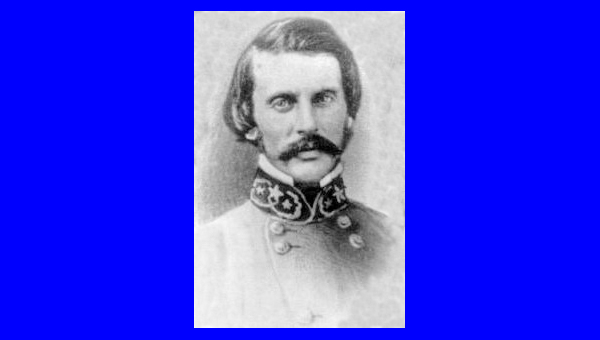July 6, 1862 – July 19, 1862
By Phil Kohn
Phil Kohn can be reached at USCW160@yahoo.com.
In the Trans-Mississippi West, Col. William Steele, knowing that he will soon be facing over 4,000 Federal troops, on July 8, 1862, leads his 350 Confederate troopers — Sibley’s rear guard, with orders to “hold the territory” — toward Ft. Bliss, in Texas. Capt. Sherod Hunter’s Arizona Rangers company is the last unit to exit Confederate Arizona. In the Indian Territory, the commandant of the department in which the territory is located, Maj. Gen. Thomas Hindman, is concerned by the Federal victory at Locust Grove earlier in the month. He orders Brig. Gen. Albert Pike, the Commandant of Indian Territory, to bring his Indian troops forward from Fort McCullough, in the Choctaw Nation, near the Red River border with Texas. Pike complies, but to Hindman’s annoyance, without urgency.
President Lincoln on July 9 visits with Maj. Gen. George McClellan at Harrison’s Landing, Virginia, southeast of Richmond. McClellan, convinced that the recent difficulties faced by his Army of the Potomac have been caused by Lincoln’s refusal to send him more troops, hands the president a letter. In the missive, McClellan points out what he sees as weaknesses in Lincoln’s military and political strategies and states that military operations should not interfere with slavery. After his meeting with Maj. Gen. McClellan, President Lincoln recalls Maj. Gen. Henry Halleck to the capital city from his posting as commander of all Federal armies in the West. In Kentucky, Confederate raider Col. John Hunt Morgan and his cavalry seize Tompkinsville, just north of the Tennessee border. In the Far West, a second detachment (comprising around 140 troops) of the Federal California Column departs Tucson for the Rio Grande. (Because of the scarcity of water en route, troops can only be sent detachment-by-detachment several days apart to allow water holes to replenish.) Col. William Steele and his Confederate force reach Ft. Bliss, in Franklin, Texas. He begins selling military stores and equipment in return for specie (gold and silver) with which to buy food.
With troops pulled from the Army of the Potomac, Maj. Gen. John Pope establishes his Union Army of Virginia on July 10 at Culpeper, about 70 miles southwest of Washington, D.C. Pope makes clear that any active resistance by civilians within his jurisdiction will be met with a harsh response, including being shot without legal process. In Kentucky, Confederate Col. John Hunt Morgan’s raiders aggressively press Federals as they are met.
On July 11, President Lincoln appoints Maj. Gen. Henry Halleck as general-in-chief of the U.S. Army. His first task: to determine why Maj. Gen. McClellan has yet to launch an effective offensive, and fire him if necessary. In Missouri, William Quantrill’s Confederate partisans fight a skirmish of several hours at Pleasant Hill, south of Independence.
Construction of the ironclad CSS Arkansas is completed on July 12 at Yazoo City, Mississippi, on the Mississippi River north of Vicksburg. In Indian Territory, Federal troops under Col. William Weer capture Tahlequah, the capital of the Cherokee Nation. Cherokee chief John Ross is arrested for having signed a treaty with the Confederacy. Albert Pike, Confederate commandant of Indian Territory, who has spent the months since the Battle of Pea Ridge, Arkansas (March 7-8, 1862), feuding with other Confederate commanders over the role of his Indian troops, resigns his position and commission, to return to private life. Pike’s departure leaves Col. Stand Watie, of the Cherokee Mounted Rifles, and Col. Douglas Cooper, of the Choctaw and Chickasaw Mounted Rifles, as the senior commanders in the Indian Territory.
To support John Hunt Morgan’s raiding in Kentucky, and to provide added distraction from Gen. Braxton Bragg’s shifting of troops of his Army of Tennessee from Tupelo, Mississippi, to Chattanooga, Tennessee, Confederate Col. Nathan Bedford Forrest on July 13, 1862, leads 1,400 cavalrymen out of Chattanooga on their first raid under his command. After heavy fighting, they capture Murfreesboro, Tennessee, disrupting Federal military traffic on the Nashville and Chattanooga Railroad that runs through the town. The Southerners also seize a large amount of military equipment and supplies.
The U.S. Congress, on July 14, passes an enabling act that creates the State of West Virginia, comprising counties that had seceded from the State of Virginia. (The new state gains admission to the Union on June 20, 1863.) In Texas, leaving 26 sick and wounded men behind at a hospital in Franklin, Col. William Steele and his battalion depart Fort Bliss for San Antonio, 630 miles away. Thus ends the Confederate invasion of New Mexico.
On July 15, the Southern ironclad ship CSS Arkansas, completed just three days earlier, attacks and damages ships of the Federal fleet at the mouth of the Yazoo River. Some Union ships retreat southward to New Orleans, while the rest scurry northward to Helena, Arkansas. In one clash, the Arkansas has broken the “river siege” of Vicksburg, now garrisoned by 16,000 Confederate troops under Maj. Gen. Earl Van Dorn. Maj. Gen. Ulysses S. Grant is given command of the Federal District of West Tennessee, bounded by the Tennessee and Mississippi Rivers. His independent command, answerable only to Washington, D.C., is tasked with capturing Vicksburg, Mississippi, and opening the Mississippi River. In the southern portion of the New Mexico Territory (formerly Confederate Arizona), the second detachment of the California Column, comprising 140 men, is attacked by a war party of 500 Apache braves led by Cochise and his father-in-law, Mangas Coloradas, as it enters Apache Pass in the Chiracahua Mountains, east of Tucson. After bitter fighting lasting almost two days, the outnumbered Californians, with the aid of two mountain howitzers, finally drive the Apaches off. In the battle, two soldiers are killed and two wounded. Nine Apaches die in the fighting.
On July 16, the rank of rear admiral — for the first time in the history of the U.S. Navy — is conferred, upon Capt. David Farragut. (Previously, the Navy’s highest rank was flag officer.)
In Washington, D.C., President Lincoln on July 17 signs into law the Second Confiscation Act, which provides for the freeing of slaves coming into areas of Federal jurisdiction from outside the Union. With 63,000 troops reporting to him (including 15,000 under Maj. Gen. William T. Sherman, at Memphis), Maj. Gen. Ulysses Grant establishes the headquarters of his independent command at Corinth, Mississippi. In Kentucky, Col. John Hunt Morgan leads his Confederate raiders in a surprise attack of Union soldiers at Cynthiana, in the northern part of the state. After several hours of fighting, the Federals withdraw, and the Southerners take over the town.
On July 18, civilian Confederate scout Adam Johnson leads a raiding party across the Ohio River from Kentucky and attacks Newburgh, Indiana, not far from Evansville. Convinced they are facing a large force, the Union garrison there surrenders, and Johnson and his men capture the town. His “force” consists of 12 men and two pieces of stove pipe mounted on a wagon to look like a cannon. Johnson, who later joins the army and achieves the rank of brigadier general, henceforth becomes known as “Stovepipe” Johnson.








